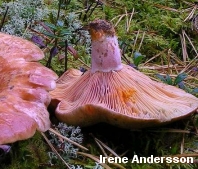| Major Groups > Gilled Mushrooms > Pale-Spored > Lactarius > Lactarius "deliciosus" group |

|
Lactarius "deliciosus" group [ Agaricomycetes > Russulales > Russulaceae > Lactarius . . . ] by Michael Kuo Illustrated to the right is Lactarius deliciosus--a phylogenetically, morphologically, and ecologically distinct European species that does not occur in North America, characterized by mycorrhizal association with pines (species of Pinus), conspicuous pot-holes on the stem surface, and thin-lined sporal ornamentation. I have seen Lactarius deliciosus in European woods and in markets, but I have not collected it for study. |
|
|
Over the last decade or so Belgian mycologist Jorinde Nuytinck and collaborators have published a series of papers (2005, 2006, 2007a, 2007b, 2007c) investigating the area of the genus Lactarius to which Lactarius deliciosus belongs: section Deliciosi. Nuytinck studied the DNA (ITS and gpd genes) of specimens from across the globe, and was able to provide a fairly detailed accounting of the section, especially in Europe, where the true Lactarius deliciosus has several look-alikes, including Lactarius deterrimus, Lactarius fennoscandicus, and Lactarius quieticolor; see Nuytinck's key to European Deliciosi for details. As for the North American mushrooms in section Deliciosi, most of our traditionally recognized species were well supported by Nuytinck's DNA results--including, among others, Lactarius indigo, Lactarius subpurpureus, and Lactarius thyinos. However, the picture was not so clear when attention was turned towards the various mushrooms traditionally called "Lactarius deliciosus" in North America. They certainly weren't Lactarius deliciosus: "Intercontinental conspecificity in this section seems much lower than assumed so far. No overlap could be shown between America and Eurasia" (2007a, p. 829). Nuytinck and collaborators felt that the deliciosus-like taxa in North America "remain problematic" (2006, p. 262) and decided "not to draw any further taxonomical conclusions and consequently not to propose any new names" (p. 297). So, for the time being at least, we're left with the existing North American taxon names and concepts for the deliciosus group--as delineated for the continent by Hesler & Smith (1979) and for California by Methven (1997):
REFERENCES: Lactarius deliciosus: (Linnaeus, 1753) Gray, 1821. (Fries, 1821; Saccardo, 1887; Heilmann-Clausen et al., 1998; Nuytinck & Verbeken, 2005; Nuytinck et al., 2006; Nuytinck et al., 2007a; Nuytinck et al., 2007b; Nuytinck et al., 2007c.) North American taxa: Hesler & Smith, 1979; Methven, 1997; Nuytinck et al., 2006. This site contains no information about the edibility or toxicity of mushrooms. Cite this page as: Kuo, M. (2011, March). Lactarius "deliciosus" group. Retrieved from the MushroomExpert.Com Web site: http://www.mushroomexpert.com/lactarius_deliciosus.html © MushroomExpert.Com |
